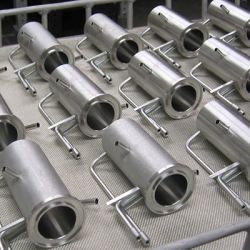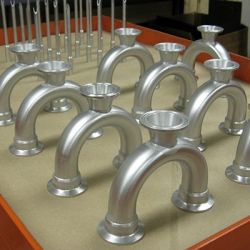SOLUTIONS & SERVICES
Solutions & Services
Vacuum Brazing
Vacuum Brazing & Joining Services
S-Bond Technologies with its partners offer a wide range of vacuum brazing and related vacuum bonding processing. S-Bond Technologies has extensive experience in brazing, soldering and affiliated materials joining methods and can assist you in your joining applications.
Braze joining of metal and ceramic components using a molten filler metal that melts above 850ºF (450ºC). Filler metals include Al-Si, Cu-Ag, Cu-Mn, Cu-P, Cu, Ag, Au, Pd, Ni-Cr-Si and Ni-Cr-Si-B as well as other less used metal fillers that will wet and adhere to metals and, in special cases, to ceramics. In such braze joining, the molten filler metals in the process, wet the clean parent material surfaces to be joined, react with the faying surfaces to form chemical bonds and/or intermetallic compounds, then the filler metal elements interdiffuse into the base materials to complete the local chemical bond to form a solid joint. Unlike welding the interaction of the base materials being joined is minimal.

Vacuum brazing takes advantage of the “absence of air” in a hot zone environment where braze filler metals can be melted in a non-contaminating environment. The vacuum atmosphere protects the base materials and the filler metals from atmospheric contaminants (especially O2 and N2) while at high temperature and prevents oxidation and nitriding which interferes with the flow, wetting and adherence of braze fillers to the parent materials being joined. In brazing, clean metal surface is imperative for the flow and wetting of metals on other surfaces. In non-vacuum brazing, chemicals are used in conjunction with molten filler metals, such that the chemical is molten (typically salts of chloride and/or flourides) and can reduce (dissolve) oxides/nitrides of the parent metals to remove the films just as the braze filler metals melt. The problem with fluxes can be they are can be unhealthy in workplaces and can remain on parts and become corrosive. Vacuum brazing is a fluxless process where the since in the protective vacuum oxides do not form and at the extremely low pressures of 10-4 to 10-6 torr, the vapor pressures of the parent metals oxides lead to the decomposition / reduction of the contaminating films on metals such as copper, steel, stainless steel and Ni-base alloys, and refractory metals. In effect the vacuum is the flux. A major advantage of a vacuum braze process is the parts come out extremely clean and ready for use directly, without the risk of retained chemical flux residues.
Vacuum Diffusion Bonding differs from vacuum brazing in that during the joining process there is no appreciative degree of molten filler metals used. Bonding is strictly achieved in the solid state with chemical bonding being achieved via the interdiffusion of the element of the base materials. Diffusion bonding takes “clean atmospheres” of high vacuum to eliminate any chemical species that will form a stable, dense film on the adjoining parent metal surfaces. Such films will prevent the interdiffusion of the elements of the adjoining base metals and thus form a diffusion barrier that will stop the interdiffusion that drives bonding. Additionally, the vacuum diffusion bonding process requires some pressure and intimate contact of surface across whose interface elements can interdiffuse. Pressures assure intimate surface contact throughout the heating process. Vacuum diffusion bonding produces joints that are near equivalent to their parent materials properties since there is not a braze filler alloy interface that has differing chemistry and thus mechanical properties. Vacuum diffusion bonding today is extensively used in high performance aircraft engine and power turbines, biomedical implants and other exacting fields, due to their extremely high properties and reliability.
Vacuum diffusion processes can also be aided by small amounts of interfacial elements/alloys that melt at the bonding temperature but quickly interdiffuse and thus are “transient liquids” that are solidified by interdiffusion of their constituent elements.

The success of vacuum brazing is effectively determined by the quality of the vacuum and the unique tooling and process controls that S-Bond Technologies and it partners have experience with.
Our collaborations offer vacuum brazing and vacuum diffusion bonding services for,
| Copper | Aluminum | Stainless Steel |
| Titanium | Refractory Metals | Superalloys |
| Ceramics | Carbides | Carbon / Diamond |
| Graphite/Graphene |
Vacuum brazing is particularly advantages for joining ceramics using “active braze fillers” which have active elements such as Ti, Hf, Zr and V added to react with ceramics for form a chemical bond at temperature is high vacuum environments. S-Bond Technologies has specific expertise in brazing metals to ceramics using direct “active braze” technology and works with our partner’s experience in commercial high quality vacuum treatments.
S-Bond Technologies, specializes in development and prototype services for developing methods and processes for bonding difficult to bond and other dissimilar materials. Our partners have extensive equipment capabilities and offers ISO, NADCAP and other industry certifications to insure the highest quality production vacuum brazing services for your production parts. Together we offer prototype to production surfaces of
Contact Us for assistance in assessing your bonding needs and meeting your vacuum brazing requirements. We offer a range of design, prototype and production services. We will assess the most optimum brazing, soldering or related bonding process and develop and qualify the processes.
More Information?
If you would like someone to contact you or provide information, please submit the information to the right.
